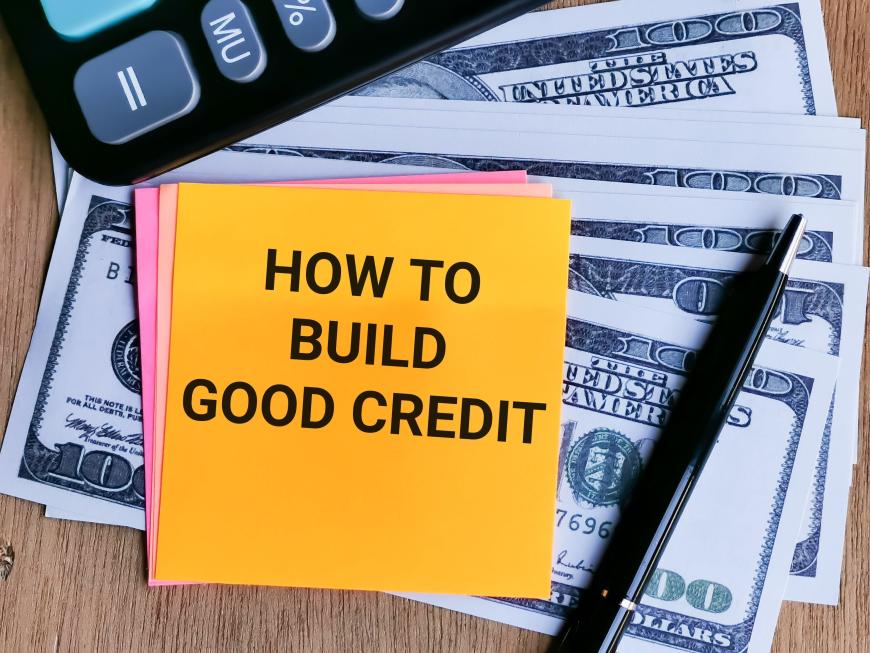
Four effective ways to improve your credit
Credit is used in decisions regarding eligibility for loans, the cost of insurance premiums, and even employment and rental applications. If you have set a goal to get a new car, rent an apartment or apply for a home equity loan and you have a lower credit score, you will want to, and sometimes need to, improve your score first.
A credit score is a calculation based on factors from your credit report at the time the score is requested. Credit scores range from 350 to 850, and a score below 700 is less than ideal. Maybe you’ve also found some negative marks on your credit report (e.g., recent late payments). Any of these could keep you from achieving your financial goals.
If you find yourself in this situation, it is important to make a plan to improve your credit so that you have a high enough score to get a loan or rent an apartment, for instance. Additionally, a higher score will save you money, giving you better insurance rates and interest rates alike. Depending on what the negative marks are on your credit report, one small change could be a major boost to your credit score. However, there is no “quick fix” when you are building your credit. Instead, you’ll have to take the “tortoise” approach and work on increasing your score steadily over time, which could be one to two years.
Here are four ways to build your credit.
1) Pay bills on time.
The FICO score was created by Fair Isaac Corporation, and it is the most common credit scoring system used. Since 35% of your FICO score is based on your payment history, paying your bills on time, all the time, is very important. In addition, late payments can stay on your credit report for more than seven years.
When lenders review credit, they not only look at how many missed payments there are, but also how recently the missed payments occurred and how many days past due the payments are. If you miss a due date, don’t panic. Simply make the payment as soon as possible. If your payment is more than 30 days overdue, call the creditor, and ask if they would consider no longer reporting the missed payment. However, your credit will be more negatively affected the longer your payments are past due.
To prevent late payments, try putting due date reminders on your calendar, or set up automatic payments for your bills. If the bill’s due date does not align with your paycheck schedule, contact your creditor, and request that they move the due date back to a later date in the month. Please note: a creditor might not move the due date if your card is currently closed and on a hardship plan or if you are late on your payments even 30 days.
2) Implement the power payment method for debt, or begin a Debt Management Plan.
Under the power payment method, you send more than the minimum payment due on one debt. Once that debt is paid off, put that payment toward another debt. This will reduce the total time to pay off debts — not to mention you’ll save money in interest overall.
Here are some suggested steps for implementing the power payment plan on your own:
- Create a budget. Know what your savings and living expenses are. Then you’ll know what you can afford to pay towards your debts.
- Create a list of what you owe. Write down the account name, balance and minimum payment for credit cards. On your list, include medical debt and bills, money owed to family and all other unsecured or secured loans.
- Start with the smallest balance. Continue sending the minimum amount due on every debt you owe, except for the account with the lowest balance. Also, continue sending payments until the lowest balance is completely paid off. If you have debts that have the same balance, first pay the one with the higher annual percent rate (APR).
- Move on to the next smallest account. As one account is paid off, take the monthly payment you were making to that account, and put it towards the next debt on your list. You’re now increasing the amount you pay on that debt.
- Use an online calculator to determine your monthly payment amounts and how long it will take to pay off each account. Our credit card calculator can be a useful tool.
Another option is a Debt Management Plan (DMP) through a nonprofit organization like LSS Financial Counseling. There is a small, one-time set up fee and a small monthly maintenance fee, but payments for unsecured debts (like credit cards) are simplified into one monthly payment. Also, the monthly payment is usually lower than what you’ve been paying, and you’ll typically have reduced interest rates under a DMP. Together, these will save you thousands of dollars in the long run.
3) Address collection accounts ASAP.
Paying off collection accounts not only helps improve your score; it also can prevent the creditor from threatening to sue you and ultimately garnish your wages. While some collection accounts might close if they have been unresolved in seven years, it is still wise to take action to pay them off.
There are two ways to address collection accounts:
A) One-time settlement
Paying the debt in full is better for your credit score, but if you don't have the money, you might be able to work out a settlement with your creditors for less than what you owe. Creditors will usually accept a settlement that is between 20-80% of the original balance owed. Settling with creditors could take some time, however, because you need to contact each creditor as you have the funds to fully pay the amount in your settlement offer.
Try to call your creditors at the end of the month. Collectors are usually looking to boost their commission checks at this time, so they might be more likely to agree to your offer.
Keep all communication you have with your creditors/collectors. You might also want to consider talking to a tax advisor if settlements would affect your taxable income.
Here are the steps to negotiating a debt settlement with your creditors:
- Send a Verification of Debt letter to the collection agency. Here is a sample debt collection response letter from the Consumer Financial Protection Bureau. The bureau has other sample letters to send to the collectors, depending on your circumstances.
- Figure out a settlement amount.
- Get the settlement offer in writing from the collector before you make a payment.
- Make a payment. Creditors usually require a payment the day you work out a settlement.
- Get a “satisfaction of debt” after you make your payment. This acts as your receipt.
IMPORTANT NOTE: Beware of debt settlement companies who offer to negotiate settlements with your creditors for a fee. These are SCAMS, and you can negotiate on your own and avoid costly fees!
B) Payment plan
You can offer your own payment plan to the collection agencies, using the Collection Repayment worksheet. When creating your plan, ask yourself, “Is the payment amount reasonable, and will it fit into my budget? Is the time it takes to pay off the debt realistic?” (Larger debts could require a longer timeline.)
A reasonable payment plan can protect you in case the collector wants to pursue a judgment against you. It might also ensure the collection agency does not sell the debt to another agency. You'll then have to contact the new collection agency and work out a new payment plan, and they could add on fees.
When the debt is paid off, make sure you get a “Satisfaction of Debt” for your records.
4) Open a secured credit card or credit builder loan.
These options are useful if you either don’t have credit or are trying to re-establish your credit. They are usually offered through credit unions and local small banks. Here is how each of these types works:
Secured credit cards require a security deposit, and the credit limit will be based on how large your security deposit is. If borrowed funds go unpaid, the card issuer takes money from your deposit.
Make small charges (e.g., gasoline) each month to your secured credit card, and stay below 30% of your available credit. For example, if your secured credit card has a limit of $500, you will always want to keep your balance below $150 in any one month.
Consider setting up this account on auto pay, and pay in full each month. That way, you never miss a payment, and you won’t pay any interest. Always be sure that you only charge on the card what you can afford to pay off within that same month. This will help you avoid getting into debt.
Credit builder loans are a type of installment loan. You make small mandatory deposits into a certificate of deposit (CD) account, and these deposits will be reported to the credit reporting agencies as on-time payments on a loan. Once you pay the entire amount required for the CD, you will receive an added bonus — an established savings account. Be sure you can afford these deposits before taking out a credit builder loan. Note: installment loans count more heavily towards your credit scores than credit cards.
LSS Financial Counseling has experienced, certified financial counselors who can create a plan with you to improve your credit. Whether it’s creating a budget, reviewing your credit report with you, and/or providing your best options for debt repayment, we can provide support.
If you want to see what a DMP would look like for you, contact us today. We’ll create a budget with you, calculate your DMP payment, and help you determine if the DMP is right for your financial situation.
Call 888.577.2227 for a free, confidential appointment, or get your support online.

Author Ray McCoy is a certified financial counselor for LSS Financial Counseling.
